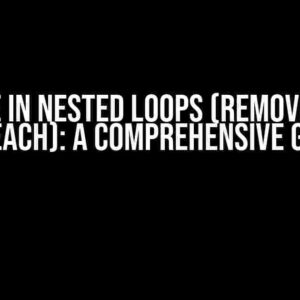Are you tired of struggling with single quotes in filenames? Do you find yourself wondering why your scripts and programs keep throwing errors whenever you try to work with files containing single quotes? Well, wonder no more! In this article, we’ll take a deep dive into the world of single quote escaping and provide you with a comprehensive guide on how to properly escape single quotes in filenames.
Why Do Single Quotes Matter in Filenames?
Before we dive into the nitty-gritty of single quote escaping, let’s take a step back and understand why single quotes are such a big deal in filenames. The reason is simple: single quotes are special characters in many programming languages and shell scripts. They’re used to enclose strings, define variables, and execute commands.
In the context of filenames, single quotes can cause chaos. Imagine you have a file named “John’s Document.txt”. If you try to reference this file in a script or program, the single quote in the filename will likely cause the script to throw an error or behave unexpectedly. This is because the single quote is interpreted as a special character, rather than a literal part of the filename.
The Consequences of Improper Single Quote Escaping
So, what happens when you fail to properly escape single quotes in filenames? Well, the consequences can be severe. Here are a few examples:
- Script errors: Unescaped single quotes can cause scripts to throw errors, fail to execute, or behave erratically.
- Data corruption: If a single quote is not properly escaped, it can lead to data corruption or loss.
- Security vulnerabilities: In some cases, unescaped single quotes can create security vulnerabilities that can be exploited by attackers.
- Inconsistent behavior: Improper single quote escaping can lead to inconsistent behavior across different systems, platforms, or environments.
Methods for Escaping Single Quotes in Filenames
Now that we’ve covered the importance of single quote escaping, let’s explore the methods for doing so. There are several ways to escape single quotes in filenames, and we’ll cover each one in detail.
Method 1: Backslash Escaping
One of the most common methods for escaping single quotes is by using backslash escaping. This involves prefixing the single quote with a backslash (\) character. For example:
file:///path/to/John\'s\ Document.txtIn this example, the backslash (\) character is used to escape the single quote in the filename. This tells the script or program to treat the single quote as a literal character, rather than a special character.
Method 2: Double Quote Enclosure
Another method for escaping single quotes is by enclosing the entire filename in double quotes. This method is particularly useful when working with command-line interfaces or scripts. For example:
file:///path/to/"John's Document.txt"In this example, the double quotes enclose the entire filename, including the single quote. This tells the script or program to treat the entire string as a single entity, rather than interpreting the single quote as a special character.
Method 3: URL Encoding
When working with URLs or web-based applications, it’s often necessary to encode special characters, including single quotes. URL encoding involves replacing special characters with their corresponding ASCII codes. For example:
file:///path/to/John%27s%20Document.txtIn this example, the single quote is replaced with its corresponding ASCII code (%27). This tells the web application or script to treat the single quote as a literal character, rather than a special character.
Now that we’ve covered the methods for escaping single quotes, let’s discuss some best practices to keep in mind:
- Consistency is key: Choose a single method for escaping single quotes and stick to it throughout your project or script. This will help avoid confusion and inconsistencies.
- Test thoroughly: Always test your scripts or programs with sample filenames containing single quotes to ensure they’re properly escaped.
- Avoid mixing methods: Avoid mixing different methods for escaping single quotes within the same script or program. This can lead to confusion and errors.
- Document your approach: Document your approach to single quote escaping in your project or script. This will help others understand how to work with files containing single quotes.
Common Pitfalls to Avoid
When working with single quote escaping, it’s easy to fall into common pitfalls. Here are a few to avoid:
| Pitfall | Description |
|---|---|
| Forgetting to escape single quotes | Failing to escape single quotes can lead to script errors or unexpected behavior. |
| Using the wrong escape method | Using the wrong escape method (e.g., backslash escaping in a URL) can lead to errors or inconsistencies. |
| Not testing thoroughly | Failing to test scripts or programs with sample filenames containing single quotes can lead to errors or unexpected behavior. |
Conclusion
In conclusion, single quote escaping is a crucial aspect of working with files and scripts. By understanding the importance of single quote escaping, the methods for doing so, and the best practices to keep in mind, you’ll be well-equipped to handle even the most challenging filenames. Remember to always test thoroughly, document your approach, and avoid common pitfalls. With practice and patience, you’ll become a master of single quote escaping!
So, the next time you encounter a filename containing a single quote, you’ll know exactly what to do. Happy coding!
Frequently Asked Question
Are you tired of dealing with troublesome filenames that contain single quotes? Worry no more! Here are the answers to your most pressing questions about escaping single quotes in filenames.
Q1: Why do I need to escape single quotes in filenames?
Single quotes are special characters that can cause problems when used in filenames, especially when working with command-line interfaces or in scripts. Escaping them ensures that your filenames are correctly interpreted and don’t cause errors.
Q2: How do I escape a single quote in a filename on a Unix-based system?
On Unix-based systems, you can escape a single quote by prefixing it with a backslash (\). For example, if your filename is `My File’s Name.txt`, you would escape it as `My File\’s Name.txt`.
Q3: What’s the best way to escape single quotes in filenames on a Windows system?
On Windows systems, you can escape single quotes by enclosing the entire filename in double quotes (“”). For example, if your filename is `My File’s Name.txt`, you would escape it as `”My File’s Name.txt”`. Alternatively, you can use the caret symbol (^) to escape the single quote, like this: `My File^’s Name.txt`.
Q4: Are there any other considerations I should keep in mind when working with filenames that contain single quotes?
Yes, be mindful of characters that have special meanings in different contexts. For example, the backslash (\) is an escape character in many programming languages, so it’s essential to properly escape it as well. Additionally, some systems may have specific rules or restrictions for filenames, so it’s always a good idea to check the documentation.
Q5: Are there any tools or software that can help me escape single quotes in filenames?
Yes, there are several tools and software available that can help you escape single quotes in filenames. For example, you can use a filename cleaner tool or a scripting language like Python or Perl to automate the process. Additionally, some command-line interfaces, like Bash, have built-in features to help with escaping special characters.


